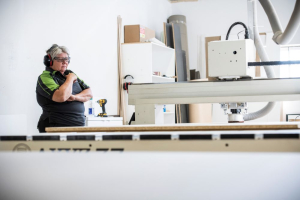Cabinetmaker, a vital job in the events industry
The events industry employs a wide variety of professionals. Those who come first to mind are project managers, producers, salespeople at trade shows, etc. But many more profiles are contributing to the success of an event.
Regarding trade shows, exhibitors’ booths are among the most visible elements. The conception and building of these structures require a whole team of professionals: project managers, designers, warehouse workers, etc.
Today we are going to look at this sometimes unsung hero, the cabinetmaker.
Time for a little history lesson
Woodworking jobs are numerous and varied: lumberjack, carpenter, joiner, cooper, woodturner, wood carver, stringed instrument maker, etc.
Photo by Michel Rohan on Pixabay
In the events industry, and more specifically when it comes to exhibition booths for trade shows, one of these crafts is vital; we are talking about the cabinetmaker.
Cabinetmakers are craftspeople who transform wood to create functional or decorative furniture (source: Wikipedia).
Historically carpenters were the ones who worked with wood, mainly to build the structure of a house. Then came joiners who specialized in smaller items.
In France, the word “ébénisterie” (cabinetmaking) appeared for the first time in a dictionary in 1732. The word itself comes from “ébène” (ebony), a rare and valuable wood. Of course, using wood to decorate or build furniture dates back a lot earlier, since antiquity for Israel and Rome and the Middle Ages for Europe. But, before the 16th century, ebony was only used for small objects, such as chess boards or small boxes.
It’s really under the reign of Louis XIV, thanks to Charles Le Brun and Charles Boulle, that marquetry veneer really starts to become ubiquitous with the use of thin layers of ebony, copper, tin, or shells. By the mid-17th century, the joiners’ corporation finally welcomed this new category of craftsmen, initially referred to as “ebony joiners.”
Nowadays, cabinetmakers use new materials and sophisticated, high-performance machines, notably Computer Numeric Controlled (CNC) Machines.
Photo by Shoot Studio
Cabinetmakers in the events industry
Let’s return to the events industry, specifically professional trade shows. Cabinetmakers are essential actors when it comes to building booths for exhibitors.
Indeed, the cabinetmaker is in charge of preparing and building all the walls and partitions, but also the furniture, following the blueprints provided by the designer. He is also an integral part of the assembly of all the components of a booth.
He has to work harmoniously with the project manager and the designer to ensure all the deadlines are met.
Photo by Shoot Studio
To complete these tasks successfully, the cabinetmaker has to master all the stages in a cabinetmaking project, i.e., conception, production, and assembly of all the components in the project. In addition, he must master the use of the tools required to complete the projects, be an expert in reading blueprints and be knowledgeable in mathematics. Finally, he needs a deep understanding of the raw materials that are used in construction. He now also needs to be able to program and operate CNC machines.
Education
In the USA, most employers prefer to hire individuals with a minimum of a high school diploma or General Educational Development (GED) credential, even though cabinetmakers are not required to have completed formal education related to the trade. Generally, a minimum of three years of experience is required to be considered a skilled craftsman. Still, some cabinetmaking apprenticeships are available after a high-school diploma and are usually completed in four years.
In the province of Quebec (Canada), specific diplomas are required to be able to work as a cabinetmaker: a Diploma of Vocational Studies (DEP) in Wood and related materials—cabinetmaking or a Diploma of College Studies (DEC) from the “École Nationale du meuble et de l’ébénisterie” (Victoriaville and Montréal).
Photo by Shoot Studio
In France, it is possible to start with a Professional Qualification (CAP) in cabinetmaking (2-year curriculum), then proceed with a Vocational Diploma (Bac Pro) in Cabinetmaking (also two years). Other diplomas are available such as a BMA (trade degree level 4) and a BTMS (vocational qualification) level 3. A master’s degree is in the process of being recognized on a national level.
How much does a cabinetmaker earn?
In the USA, cabinetmakers earned an average of $40,070 annually in 2021. In addition, the BLS (U.S. Bureau of Labor Statistics) predicted a 4% growth in employment for the woodworking field between 2021 and 2031, with good job prospects for highly qualified candidates.
In Quebec, the hourly wage varies between Can$16 and Can$29.71, depending on experience and qualifications. This represents annual earnings between Can$33,280 and Can$61,796.80 (40-hour-week basis).
In France, a novice cabinetmaker is usually paid the minimum wage (which was set at €1,709.28 monthly before taxes as of January 2023, i.e., €20,511.36 per year). On the other hand, an experienced artisan can reach up to €3,800 per month, i.e., €45,600 per year.
In conclusion
Cabinetmakers are vital when it comes to building exhibition booths, as they move a booth from a project phase to a built structure.
At totm exposition, we are very proud of our team of cabinetmakers who bring to life the ideas of our designers and clients.
We are always looking for talented craftspeople! So if you are interested or know someone who might want to join a dynamic and friendly team, please get in touch!
Author : Veronique Colombani







